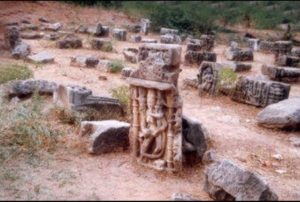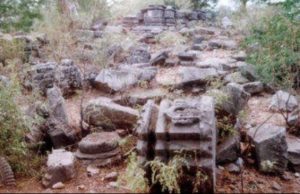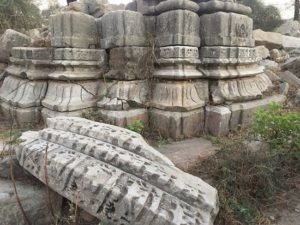Rajasthan
List of Masjids in Rajasthan which was built by destroying Hindu temples
LIST OF MOSQUES IN RAJASTHAN WHICH WERE BUILT AFTER DEMOLISHING THE HINDU TEMPLES
We give below, state-wise and district-wise, the particulars of Muslim monuments which stand on the sites and/or have been built with the materials of Hindu temples, and which we wish to recall as witnesses to the role of Islam as a religion and the character of Muslim rule in medieval India. The list is the result of a preliminary survey. Many more Muslim monuments await examination. Local traditions which have so far been ignored or neglected have to be tapped on a large scale.
We have tried our best to be exact in respect of locations, names and dates of the monuments mentioned. Even so, some mistakes and confusions may have remained. It is not unoften that different sources provide different dates and names for the same monument. Many Muslim saints are known by several names, which create confusion in identifying their mazars or dargahs. Some districts have been renamed or newly, created and a place which was earlier under one district may have been included in another. We shall be grateful to readers who point out these mistakes so that they can be corrected in our major study. This is only a brief summary.
Sita Ram Goel
It should be kept in mind that the list below doesn’t include all the temples destroyed by Muslims and converted to mosques. The below is the list of mosques and Dargahs where evidences exists of having been made after destroying the temples at these locations. In many mosques, Muslim rulers were able to eradicate all signs of temples, and hence not given in below list.
Anyone is free to visit the below list of mosques and see the remnants and materials of Hindu temples used in their construction. Archaeological Survey of India should conduct an excavation of below mosques to find out more about the ancient temples in these locations and possible mass graves around the mosque sites.
I. AJMER DISTRICT
It was a Hindu capital converted into a Muslim metropolis. The following monuments stand on the site of and/or are built with materials from temples.
1. Adhai-Din-ka-Jhonpra (1199).
2. Qalandar Masjid at Taragarh.
3. Ganj-i-Shahidan at Taragarh.
4. Dargah of Muinud-Din Chisti (d.1236).
5. Chilia-i-Chishti near Annasagar Lake.
6. Dargah and Mazar of Sayijid Husain at Taragah.
7. Jahangiri Mahal at Pushkar.
8. Shahjahani Masjid (1637).
9. Annasagar Baradari.
II. ALWAR DISTRICT
Alwar
10. Mazar of Makhdum Shah. Temple site.
Bahror
11. Dargah of Qadir Khan. Temple site.
12. Masjid near the Dargah. Temple site.
Tijara
13. Bhartari Mazar. Converted temple.
14. Masjid near the Dargah. Temple site.
III. BHARATPUR DISTRICT
Barambad
15. Masjid (1652-53). Temple site.
Bari
16. Graveyard of Arabs and Pathans. Temple site.
17. Masjid (1510). Temple site.
Bayana
18. Ukha or Nohara Masjid. Converted Usha Temple.
19. Qazipara Masjid (1305). Temple materials used.
20. Faujdari Masjid. Temple materials used.
21. Syyidpara Masjid. Temple materials used.
22. Muffonki Masjid. Temple materials used.
23. Pillared Cloister at Jhalar Baoli. Temple materials used.
24. Idgah near Jhalar Baoli. Temple site.
25. Taleti Masjid in the Bijayagarh Fort. Converted temple.
26. Abu Qandahar Graveyard. Temple site.
27. Masjid in Bhitari-Bahari Mahalla. Vishnu Temple materials used.
Etmada
28. Pirastan. Temple site.
Kaman
29. Chaurasi Khamba Masjid. Converted Kamyakesvara Temple.
30. Fort. Temple materials used.
IV. CHITTAURGARH DISTRICT
31. Mazar of Ghaibi Pir and the surrounding Graveyard. Temple sites.
32. Qanati Masjid in the same area. Temple site.
V. JAIPUR DISTRICT
Amber
33. Jami Masjid (1569-70). Temple site.
Chatsu
34. Chhatri of Gurg Ali Shah (d.1571). Temple materials used.
35. Nilgaron-ki-Masjid (1381). Temple site.
Dausa
36. Jami Masjid (1688-89). Temple site.
Naraina
37. Jami Masjid (1444). Temple materials used.
38. Tripolia Darwaza. Temple materials used.
Sambhar
39. Ganj-i-Shahidan. Temple site.
40. Dargah of Khwaja Hisamud-Din Jigarsukhta. Temple site.
41. Masjid in Mahalla Nakhas (1695-96). Temple site.
42. Masjid in Rambagh (1696-97). Temple site.
Tordi, Khari Baoli. Temple materials used.
VI. JAISALMER DISTRICT
43. Jaisalmer, Faqiron-ka-Takiya. Temple site.
44. Pokaran, Masjid (1704-05). Temple site.
VII. JALOR DISTRICT
Jalor
45. Shahi or Topkhana Masjid (1323). Parsvanatha Temple materials used.
46. Idgah (1318). Temple site.
47. Baoliwali Masjid (1523). Temple site.
Sanchor
48. , Jami Masjid (1506). Temple site.
VIII. JHALAWAR DISTRICT
Sunel
49. Masjid (1466-67). Temple site.
IX. JHUNJHUNU DISTRICT
Narhad
50. Jami Masjid. Temple materials used.
X. JODHPUR DISTRICT
Jodhpur
51. Yak-Minar-ki-Masjid (1649). Temple site.
Mandor
52. Shahi Masjid. Temple materials used.
53. Ghulam Khan-ki-Masjid. Temple materials used.
54. Dargah of Tanna Pir. Temple materials used.
Pipar City
55. , Jami Masjid (1658). Temple. site.
XI. KOTA DISTRICT
Baran
56. Masjid (1680). Temple site.
Bundi
57. Miran Masjid on the hill east of the town. Temple site.
Gagraun
58. Jami Masjid (1694). Temple site.
59. Dargah of Hazrat Hamidud-Din known as Mittha Shah. Temple site.
Shahabad
60. Sher Shah Suri-ki-Masjid. Temple site.
61. Jami Masjid. (1671-72). Temple site.
62. Dargah of Rahim Khan Data (1534-35). Temple site.
Shergarh
63. Fort of Sher Shah Suri. Brahmanical, Buddhist and Jain temple materials used.
XII. NAGAUR DISTRICT
Amarpur
64. Masjid (1655). Temple site.
Bakalia
65. Masjid (1670). Temple site.
Balapir
66. Masjid. Temple site.
Badi Khatu
67. Shahi Masjid (around 1200). Temple materials used.
68. Qanati Masjid (1301). Temple site.
69. Pahariyon-ki-Masjid and Chheh Shahid Mazars. Temple materials used.
70. Jaliyabas-ki-Masjid (1320). Temple site.
71. Badi and Chhoti Masjid in Mahalla Sayiddan. Temple site.
72. Khanzadon-ki-Masjid (1482). Temple site.
73. Masjid and Dargah of Muhammad Qattal Shahid (1333). Temple materials used.
74. Dhobiyon-ki-Masjid. Temple site.
75. Masjid-i-Sangatrashan (1639). Temple site.
76. Dargah of Baba Ishaq Maghribi (1360). Temple site.
77. Dargah of Samman Shah. Temple sites.
78. Ganj-i-Shahidan. Temple site.
79. Mominon-ki-Masjid (1667). Temple site.
80. Fort. Temple materials used.
Basni
81. Badi Masjid (1696). Temple site.
Chhoti Khatu
82. Dargah of Shah Nizam Bukhari (1670). Temple site.
Didwana
83. Qazion-ki-Masjid (1252). Temple site.
84. Masjid in Gudri Bazar (1357). Temple site.
85. Band (closed) Masjid (1384). Temple site.
86. Shaikon-ki-Masjid (1377). Temple site.
87. Jami Masjid. Temple site.
88. Qala-ki-Masjid. Temple site.
89. Havala Masjid. Temple site.
90. Sayyidon-ki-Masjid. Temple site.
91. Takiya-ki-Masjid (1582-83). Temple site.
92. Kachahri Masjid (1638). Temple site.
93. Dhobion-ki-Masjid (1662).
94. Julahon-ki-Masjid (1664). Temple site.
95. Loharon-ki-Masjid (1665). Temple site.
96. Bisatiyon-ki-Masjid (1675-76). Temple site.
97. Mochion-ki-Masjid (1686). Temple site
98. Shah Changi Madari Masjid (1711). Temple site.
99. Idgah. Temple site.
100. Graveyard near Delhi Darwaza. Temple site.
101. Din Darwaza (1681). Temple site.
102. Mazar of Rashidud-Din Shahid. Temple site.
Kathoti
103. Masjid (1569-70). Temple site.
Kumhari
104. Masjid and Dargah of Bala Pir (1496-97). Temple site.
105. Qalandari Masjid. Temple site.
Ladnun
106. Jami Masjid (1371). Temple materials used.
107. Hazirawali or Khalji Masjid (1378-79). Temple site.
108. Shahi Masjid. Temple materials used.
109. Dargah of Umrao Shahid Ghazi (1371). Temple site.
110. Graveyard near the above Dargah. Temple site.
111. Mazar-i-Murad-i-Shahid. Temple site.
Loharpura
112. Dargah of Pir Zahirud-Din. Temple site.
113. Chhoti Masjid (1602). Temple site.
Makrana
114. Jami Masjid. (Sher Shah). Temple site.
115. Masjid near Pahar Kunwa (1653). Temple site.
116. Masjid in Gaur Bas (1678). Temple site.
117. Masjid (1643). Temple site.
Merta
118. Masjid in Salawtan (1625-26). Temple site.
119. Masjid in Gaditan (1656). Temple site.
120. Jami Masjid. (1665). Temple site.
121. Mochiyon-ki-Masjid (1663). Temple site.
122. Ghosiyon-ki-Masjid (1665). Temple site.
123. Mominon-ki-Masjid (1666). Temple site.
124. Masjid in Maharaj-ki-Jagir (1666). Temple site
125. Chowk-ki-Masjid (1670). Temple site.
126. Hajjamon-ki-Masjid (1686-87). Temple site.
127. Miyanji-ki-Masjid (1690-91). Temple site.
128. Sabungaron-ki-Masjid. Temple site.
129. Dargah of Ghaus Pir. Temple site.
130. Takiya Kamal Shah. Temple site.
Nagaur
131. Mazar of Pir Zahirud-Din. Temple site.
132. Dargah of Baba Badr. Temple site.
133. Dargah of Sufi Hamidud-Din Nagauri Chishti. Temple site.
134. Dargah of Shykh Abdul Qadir Jilani. Temple site.
135. Dargah of Makhdum Husain Nagauri. Temple site.
136. Dargah of Ahmad Ali Bapji. Temple site.
137. Dargah of Sayyid Imam Nur (1527). Temple site.
138. Dargah of Shah Abdus-Salam. Temple site.
139. (xi) Dargah of Miran Sahib. Temple site.
140. (xii) Shams Khan Masjid near Shamsi Talav. Temple materials used.
141. (xiii) Jami Masjid (1553). Temple site.
142. (xiv) Ek Minar-ki-Masjid (1505-06). Temple site.
143. (xv) Dhobiyon-ki-Masjid (1552). Temple site.
144. (xvi) Chowk-ki-Masjid (1553). Temple site.
145. (xvii) Mahawaton-ki-Masjid (1567-68). Tempe site.
146. (xviii) Hamalon-ki-Masjid (1599-1600). Temple site.
147. (xix) Shah Jahani Masjid at Surajpole. Converted temple.
148. (xx) Masjid outside the Fort (1664). Temple site.
149. (xxi) Kharadiyon-ki-Masjid(1665). Temple site
150. (xxii) Ghosiyon-ki-Masjid (1677). Temple site.
151. (xxiii) Masjid near Maya Bazar (1677). Temple site.
152. (xxiv) Qalandron-ki-Masjid. Temple site.
153. (xxv) Kanehri Julahon-ki-Masjid (1669). Temple site.
154. (xxvi) Sayyidon-ki-Masjid (1433-34). Temple site.
155. (xxvii) Akhadewali Masjid (1475). Temple site.
Parbatsar
156. Mazar of Badrud-Din Shah Madar. Temple site.
Ren
157. Masjid (1685). Temple site.
Rohal
158. Qazioyn-ki-Masjid (1684). Temple site.
Sojat
159. Masjid (1680-81). Temple site.
XIII. SAWAI MADHOPUR DISTRICT
Garh
160. Qala-ki-Masjid (1546-47). Temple site.
Hinduan
161. Rangrezon-ki-Masjid (1439). Temple site.
162. Masjid in the Takiya of Khwaja Ali. Temple site.
163. Kachahri Masjid (1659-60). Temple site.
164. Bara Khamba Masjid (1665). Temple site.
165. Graveyard east of the Talav. Temple site.
166. Masjid and Mazar of Rasul Shah. Temple site.
Ranthambor
167. Qala-ki-Masjid. Temple materials used.
XIV. SIKAR DISTRICT
168. Revasa, Masjid. Temple materials used.
XV. TONK DISTRICT
Nagar
169. Ishakhan Baoli. Temple materials used.
XVI. UDAIPUR DISTRICT
Mandalgarh
170. Alai Masjid. Converted Jain Temple.
EVIDENCE IS AVAILABLE THAT IN RAJASTHAN THE ABOVE MENTIONED MOSQUES AND DARGAHS WERE CONSTRUCTED BY DESTROYING HINDU TEMPLES. BUT IN MANY OTHER CASES MUSLIMS SUCCEEDED IN REMOVING ALL TRACES OF TEMPLES FROM THE MOSQUES. IN SUCH CASES ONLY AN EXCAVATION BY ASI WILL REVEAL THE DESTROYED TEMPLES.
WHILE MUSLIMS ASK FOR REBUILDING THE ILLEGAL MOSQUE IN AYODHYA, WHY SHOULD NOT HINDUS DEMAND THE RECONSTRUCTION OF THE DESTROYED TEMPLES IN INDIA?




